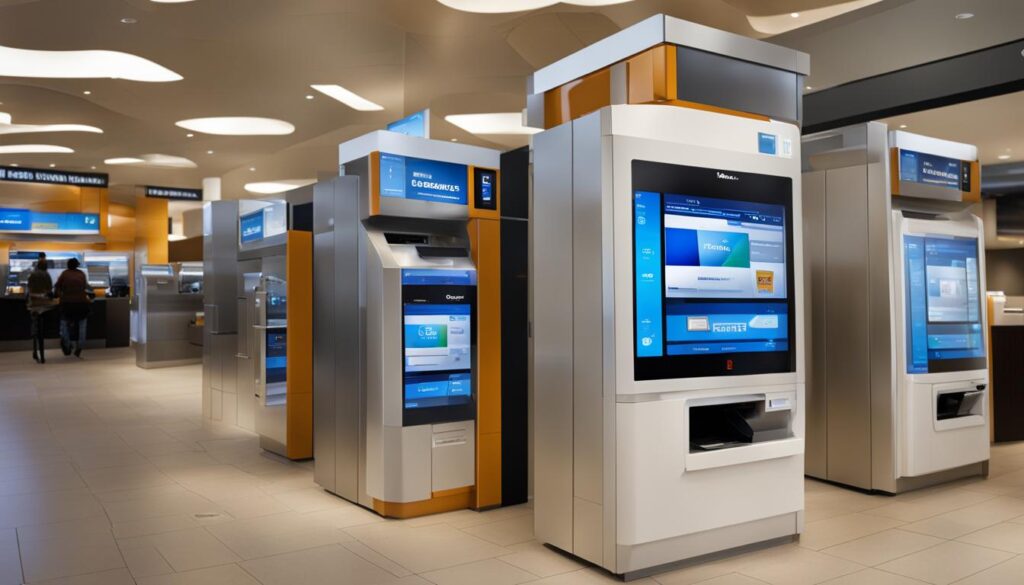In today’s rapidly evolving banking industry, information technology (IT) plays a crucial role in ensuring the efficiency, security, and innovation of banking operations. From enhancing customer experiences to streamlining processes, IT infrastructure in banking has transformed the way financial institutions operate.
So, what exactly is information technology at a bank? It encompasses various systems, hardware, software, and networks that enable banks to manage data, communicate internally and externally, and provide digital services to customers. From the robust IT security measures that protect sensitive customer information to the technology-driven advancements that improve banking services, IT is the foundation of modern banking.
One of the primary roles of technology in banking is facilitating digital transformation. As customers increasingly demand convenient and personalized banking experiences, banks have leveraged information technology to develop digital channels, such as online and mobile banking. These channels allow customers to perform a wide range of transactions, check their account balances, transfer funds, and even make purchases, all from the comfort of their devices.
Furthermore, banking IT services enable financial institutions to adapt to the ever-changing market landscape quickly. By harnessing the power of technology trends, such as artificial intelligence, blockchain, and the Internet of Things, banks can enhance operational efficiency, make more informed business decisions, and stay ahead of their competitors.
As banks continue to embrace information technology advancements, it’s crucial to prioritize IT security. With the growing risks of cyber threats and data breaches, banks invest heavily in robust security measures to protect customer data and maintain their trust.
Overall, information technology has revolutionized the banking industry, empowering banks to deliver innovative services, create seamless customer experiences, and adapt to the digital era.
Contents
- 1 The Evolution of Banking Technology
- 2 Retail Banking and Technology
- 3 The Rise of Digital-only Banks
- 4 The Impact of Mobile Banking
- 5 The Power of Online Banking
- 6 Conclusion
- 7 FAQ
- 7.1 What is information technology (IT) in the banking industry?
- 7.2 How is technology transforming the banking industry?
- 7.3 How has technology advanced in the banking industry over the years?
- 7.4 What is the role of technology in retail banking?
- 7.5 What are digital-only banks?
- 7.6 What is the impact of mobile banking?
- 7.7 How does online banking differ from mobile banking?
- 7.8 What is the future of banking technology?
- 8 Source Links
Key Takeaways:
- Information technology (IT) is essential for the efficient, secure, and innovative functioning of banks.
- IT infrastructure in banking encompasses systems, hardware, software, and networks that enable data management and digital services.
- Digital transformation in banking is driven by IT, facilitating online and mobile banking experiences for customers.
- Technology trends like AI, blockchain, and IoT contribute to operational efficiency and informed decision-making in banks.
- IT security is crucial to safeguard customer data and maintain trust in the banking industry.
The Evolution of Banking Technology
Banking technology has undergone a remarkable evolution over the years, revolutionizing the way financial institutions operate and deliver services to their customers. From the early days of computerization to the advent of digital banking, technological advancements have played a crucial role in shaping the modern banking landscape.
In the 1980s, banks embarked on a journey to computerize their branches, shifting from manual processes to automated systems. This marked the beginning of the history of banking technology, as it laid the foundation for future innovations. The computerization of branches enabled banks to efficiently manage customer accounts, process transactions, and handle other banking operations.
However, it was in the 1990s that banking technology truly took off with the emergence of total branch automation packages and internet technology. Total branch automation packages provided banks with comprehensive solutions to automate various banking processes, making them more efficient and cost-effective. At the same time, internet technology opened up new possibilities for online banking, allowing customers to access their accounts, make transactions, and perform other banking activities from the comfort of their homes.
The introduction of mobile technology further fueled the advancements in banking technology. With the rise of smartphones and mobile apps, banks began to offer mobile banking services, enabling customers to manage their finances on the go. Mobile banking brought a new level of convenience to banking, allowing customers to check account balances, transfer funds, and even deposit checks using their mobile devices.
The Rise of Neobanks
In recent years, we have witnessed the rise of neobanks, which are digital-only banks that operate solely through mobile and web-based platforms. Neobanks have disrupted the traditional banking model by offering innovative features, seamless user experiences, and personalized financial services. These digital-native banks have gained popularity among tech-savvy customers, who seek a modern and convenient banking experience.
The key drivers behind the success of neobanks are their advanced technological capabilities and customer-centric approach. Neobanks leverage cutting-edge technologies such as artificial intelligence (AI), big data analytics, and machine learning to deliver personalized financial insights, automate processes, and enhance the overall banking experience. By harnessing the power of digital technology, neobanks are able to provide fast, secure, and user-friendly banking services to their customers.
Furthermore, neobanks have embraced open banking principles and partnerships, allowing them to seamlessly integrate with other financial service providers and offer a wider range of products and services. This collaborative approach enables neobanks to deliver comprehensive and customized solutions to meet the unique needs of their customers.
The Future of Banking Technology
The evolution of banking technology shows no signs of slowing down. As we look ahead, several emerging technologies are poised to transform the banking industry even further.
Blockchain technology holds great promise for improving the security, transparency, and efficiency of financial transactions. By decentralizing record-keeping and eliminating the need for intermediaries, blockchain has the potential to revolutionize payment processing, cross-border transactions, and identity verification in banking.
Artificial intelligence (AI) and machine learning are also expected to play a significant role in the future of banking technology. AI-powered chatbots and virtual assistants can provide personalized assistance to customers, streamline customer support functions, and improve fraud detection. Machine learning algorithms can analyze vast amounts of data to identify patterns and make more accurate predictions, helping banks in risk assessment, fraud prevention, and investment decision-making.
Moreover, the Internet of Things (IoT) has the potential to transform how banks and customers interact. IoT devices, such as wearables and smart home appliances, can provide real-time data on customers’ financial behaviors and preferences. This data can be used to offer customized financial advice, targeted promotions, and personalized banking experiences.
As banking technology continues to evolve, it is clear that digital banking, online banking, mobile banking, and neobanks will continue to shape the future of the industry. The ongoing advancements in technology present opportunities for enhanced customer experiences, increased efficiency, and improved security in banking services.
“The advent of technology has transformed banking from a brick-and-mortar industry to one that is accessible anytime, anywhere. The evolution of banking technology has empowered customers with greater control over their finances and has fundamentally changed the way banks operate.”
With the rapid pace of innovation, it is essential for banks to embrace these advancements, adapt to changing customer expectations, and leverage technology to stay competitive in the ever-evolving digital landscape.
| Key Technological Advancements | Impact on Banking |
|---|---|
| Computerization of branches | Efficient management of customer accounts and banking operations |
| Total branch automation packages | Improved efficiency and cost-effectiveness of banking processes |
| Internet technology | Introduction of online banking and access to banking services anywhere |
| Mobile technology | Convenient access to banking services through mobile devices |
| Neobanks | Disruptive digital-only banks offering innovative and personalized services |
Retail Banking and Technology
Retail banking, also known as consumer banking, refers to the services provided by banks to individual customers. These services include savings and checking accounts, credit and debit cards, and loans. In recent years, technology has significantly transformed the retail banking industry, driving operational efficiency and cost reduction.
Banks are embracing Banking-as-a-Service (BaaS) platforms to remain competitive in the retail banking landscape. BaaS allows banks to diversify their product offerings and improve customer experience by partnering with fintech companies and leveraging advanced technology solutions. This strategic approach enables banks to streamline their operations, reduce costs, and offer innovative services that cater to changing customer needs.
One of the key aspects of retail banking technology is mobile banking. With the widespread adoption of smartphones, many customers now rely on mobile apps to access and manage their accounts. Mobile banking enables customers to perform various transactions, such as checking account balances, transferring funds, and paying bills, at their convenience. This shift towards mobile banking has not only enhanced the overall customer experience but has also driven cost reduction for banks.
Benefits of Retail Banking Technology:
- Operational Efficiency: Technology streamlines processes, automates tasks, and enables seamless integration between different banking systems, resulting in improved efficiency and productivity.
- Cost Reduction: By leveraging technology, banks can reduce operational costs associated with manual processes and physical branches, ultimately leading to cost savings.
- Enhanced Customer Experience: Retail banking technology allows banks to provide personalized and convenient services to customers, strengthening customer satisfaction and loyalty.
“The integration of technology in retail banking has revolutionized the way banks operate, enabling them to optimize processes and deliver superior customer experiences.”
– Industry Expert
With the rapid advancement of technology, retail banking will continue to evolve, embracing innovative solutions to meet customer demands and adapt to changing market dynamics. The focus will remain on enhancing operational efficiency, reducing costs, and delivering an exceptional customer experience through cutting-edge technology.

| Benefits of Retail Banking Technology | Description |
|---|---|
| Operational Efficiency | Streamlined processes, automation, and seamless integration between systems |
| Cost Reduction | Savings through automation, reduced manual processes, and physical branch optimization |
| Enhanced Customer Experience | Personalized and convenient services leading to higher customer satisfaction and loyalty |
By leveraging technology, retail banks can drive operational excellence, optimize costs, and deliver a seamless banking experience that meets the evolving needs of their customers.
The Rise of Digital-only Banks
Digital-only banks, also known as neobanks, are transforming the banking industry and shaping its future. These modern banks have captured the attention of digitally-savvy millennials and Gen Zers with their advanced mobile banking tools and innovative features. With no-fee accounts, streamlined processes, and personalized money management options, neobanks have gained popularity among customers seeking convenient and user-friendly banking experiences.
Although digital-only banks initially faced regulatory barriers in the United States, recent developments indicate their potential for growth in the market. These neobanks leverage cutting-edge technologies such as application programming interfaces (APIs), blockchain, artificial intelligence (AI), and the Internet of Things (IoT) to deliver seamless and efficient services to their customers.
One of the key advantages of digital-only banks is the utilization of APIs, which allow secure sharing of proprietary data with authorized third parties. This integration enables customers to access a wider range of services and enables the banks to offer more tailored solutions for their users.
Neobanks leverage innovative technologies like APIs, blockchain, AI, and IoT to deliver a seamless banking experience that’s tailored to your needs.
Blockchain technology plays a significant role in digital-only banks, offering enhanced security, transparency, and efficiency in financial transactions. By leveraging blockchain, these banks can streamline processes and reduce costs, ultimately providing faster and more secure services to their customers.
AI-powered chatbots and voice assistants have become essential features of digital-only banks, enhancing customer interactions and authentication processes. With AI-driven solutions, customers can get personalized assistance, ask questions, and perform a range of banking transactions using natural language interfaces.
The Internet of Things (IoT) is another technology that digital-only banks harness to improve their services. By integrating IoT devices, customers can manage and monitor their accounts, transactions, and financial goals through smart devices such as wearables or connected home appliances.
Recent Developments in US Neobanks
In the US, digital-only banks have faced regulatory challenges that have slowed their growth compared to other regions. However, recent developments indicate a promising future for digital banking in the country. Some prominent examples of digital-only banks in the US include Chime, Varo Money, and Ally Bank, which offer digital-first solutions and innovative features to attract customers.
Chime, for instance, offers fee-free banking, early access to direct deposits, and automated savings features to help customers build their financial well-being. Varo Money provides a range of financial services, including no-fee checking and savings accounts, as well as access to loans and credit. Ally Bank, known for its strong digital presence, offers a full suite of online banking products and services.
As the demand for digital banking continues to rise, both traditional banks and digital-only banks are exploring opportunities to enhance their offerings and provide customers with a convenient and secure banking experience.

With the rise of digital-only banks, the banking industry is undergoing a significant transformation. These banks are reshaping the way financial services are delivered, putting customer experience at the forefront. By leveraging mobile banking tools and embracing advanced technologies, digital-only banks are meeting the demands of the digital age and redefining the future of banking.
The Impact of Mobile Banking
Mobile banking has revolutionized the way we manage our finances, providing a convenient and accessible solution for banking on the go. With the rapid growth of mobile usage among millennials and Gen Zers, mobile banking has become an essential feature for financial institutions to stay competitive and meet the evolving needs of their customers.
One of the key advantages of mobile banking is its ease of use. It allows users to make deposits, transfers, and monitor their account balances with just a few taps on their smartphones. With mobile banking, you have the freedom to access your finances anytime and anywhere, without the need to visit a physical branch or use a computer.
Mobile banking also offers an array of features that enhance the overall banking experience. Money management tools, such as spending tracking and savings goals, allow you to keep a close eye on your financial habits and work towards your financial goals. These features help you make better financial decisions and gain greater control over your money.
Security is a top concern for mobile banking users, and financial institutions have implemented robust security measures to ensure the protection of customer data. Features like card holds, travel alerts, and transaction dispute filing provide added layers of security and peace of mind. Mobile banking apps employ encryption and authentication protocols to safeguard your personal and financial information.
While online banking still holds its prominence, mobile banking is growing at a much faster rate. The convenience and accessibility offered by mobile banking have made it the preferred choice for many users. With just a few taps on your smartphone, you can pay bills, track expenses, and even redeem rewards. Mobile banking truly puts the power of banking in the palm of your hand.
The Power of Online Banking
Online banking, part of the broader concept of digital banking, is a convenient way to manage your finances through various digital channels, including mobile apps and desktop. While mobile banking has gained significant popularity, online banking still holds its ground for certain tasks such as bill pay and reward redemption.
Many banks emphasize online banking for these specific tasks due to its user-friendly interface and comprehensive functionality. By leveraging online banking, you can conveniently pay bills online and redeem rewards without the necessity of visiting a physical branch.
However, the rapid growth of mobile banking demonstrates the strong demand for mobile tasks among millennials and Gen Zers. The convenience and flexibility offered by mobile banking have attracted a massive user base. In fact, about half of all online banking customers are also active mobile banking users.
The preference for mobile banking over online banking is further fueled by the constant advancements in mobile technology and the desire for instant access and multitasking capabilities. The seamless integration of mobile banking into our daily lives enables us to conveniently manage our finances anytime, anywhere.
To provide a comprehensive understanding of the advantages of online banking, here’s a breakdown of the key benefits:
- Convenience: Online banking allows you to access your accounts, check balances, and perform transactions at your convenience, 24/7.
- Accessibility: With online banking, you can manage your finances from the comfort of your home or on the go, with just a few clicks or taps on your device.
- Cost Savings: Online banking eliminates the need for paper statements and physical branches, reducing administrative costs for banks and potentially leading to cost-saving benefits for customers.
- Efficiency: Online banking streamlines processes, such as bill payments and fund transfers, making them faster and more efficient compared to traditional methods.
- Financial Insights: Online banking platforms often provide personal finance management tools and insights, allowing you to track your expenses, set budgets, and analyze your financial habits.
“Online banking offers unrivaled convenience, allowing you to manage your finances with ease and efficiency.”
While online banking still plays a crucial role in the banking landscape, the dominance of mobile banking suggests that the future of banking technology leans heavily towards mobile solutions. Younger generations, in particular, are embracing the mobile banking experience, driven by their preference for seamless digital interactions and on-the-go accessibility.

Conclusion
The role of information technology (IT) in the banking industry cannot be overstated. IT enables banks to operate efficiently, deliver innovative services, and safeguard customer data. From retail banking to mobile banking and the emergence of digital-only banks, technology has transformed the way banking is done. The future of banking technology lies in consumer-driven advancements such as APIs, AI, blockchain, and IoT. As technology continues to evolve, banks must embrace these developments to remain competitive and meet the growing demands of customers for secure, convenient, and personalized digital banking experiences.
Information technology at a bank encompasses the entire IT infrastructure and technology systems that power banking operations. It enables seamless digital transformations, allowing banks to adapt to the ever-changing market landscape. The role of technology in banking extends from streamlining internal processes to enhancing customer experiences. With advancements such as digital banking, online and mobile banking, and the rise of neobanks, technology has revolutionized the way customers interact with banks and manage their finances.
Furthermore, information technology advancements in banking have paved the way for numerous banking IT services. These services range from online and mobile banking applications to robust IT security measures. Banks are investing heavily in IT security to protect sensitive customer data from unauthorized access and cyber threats. Additionally, technology trends in banking, such as the use of AI-powered chatbots, blockchain for secure transactions, and IoT integration, are shaping the future of the industry.
In conclusion, as the banking industry embraces digital transformation, the role of information technology becomes increasingly crucial. Banks must leverage technology to enhance operational efficiency, provide innovative banking solutions, and ensure the security of customer information. By staying ahead of technology trends and meeting customer expectations, banks can thrive in an increasingly digital world. The future of banking lies in harnessing the power of technology to deliver secure, convenient, and personalized banking experiences to customers.
FAQ
What is information technology (IT) in the banking industry?
Information technology in the banking industry refers to the use of advanced systems and infrastructure to enhance banking operations and services. It includes technologies used for tasks such as online banking, mobile banking, data management, and security.
How is technology transforming the banking industry?
Technology is transforming the banking industry by enabling banks to adapt to changing market environments, reduce costs, communicate effectively, and access diverse markets. It has revolutionized banking services, allowing customers to perform various transactions online, access accounts, transfer funds, and make purchases.
How has technology advanced in the banking industry over the years?
Technology in the banking industry has come a long way. In the 80s, banks started computerizing their branches, and in the 90s, total branch automation packages and internet technology emerged. The advent of the internet and mobile technology has revolutionized the delivery of banking products and services.
What is the role of technology in retail banking?
Technology plays a crucial role in retail banking by improving operational efficiency and reducing costs. Banks are launching Banking-as-a-Service (BaaS) platforms to remain competitive, diversify their offerings, and enhance customer experience. Mobile banking has become essential, enabling customers to access and manage their accounts through mobile apps.
What are digital-only banks?
Digital-only banks, also known as neobanks, are banks that operate solely through digital channels, offering no-fee accounts, streamlined processes, and personalized money management features. They have gained popularity among millennials and Gen Zers and utilize technologies such as APIs, blockchain, AI, and IoT to provide innovative services.
What is the impact of mobile banking?
Mobile banking has become a must-have feature for financial institutions to stay competitive. It allows users to make deposits, transfers, and monitor their finances with ease. Money management features, such as spending tracking and savings goals, enhance the overall banking experience. Security features ensure the safety of customer data.
How does online banking differ from mobile banking?
Online banking refers to banking through digital channels, including mobile apps and desktop. While online banking still serves a purpose for certain tasks like bill pay and reward redemption, mobile banking has surpassed it in popularity. The future of banking technology leans towards the mobile market as younger generations prefer mobile banking.
What is the future of banking technology?
The future of banking technology is driven by consumer-driven innovations such as APIs, AI, blockchain, and IoT. These technologies enable secure data sharing, streamline processes, reduce costs, and enhance customer interaction. It is expected to revolutionize the banking industry by 2025.




